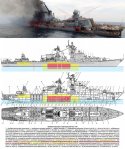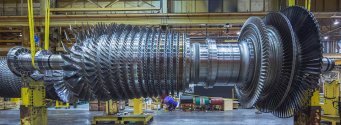Shieffield was Batch 1 of Type 42 - it had 3500t standard displacement and 120m length. Moskva had 9400t standard displacement and 186m length.
Stark had about 3500t standard displacement was hit by two Exocets and survived and returned to service. Sp this can't be the explanation.
Here's one that I put it together after I saw the photos this morning, because I was waiting for the photos since the news broke. It's still a speculation but it seems to me that it manages to integrate all the pieces of information that were released previously into a coherent scenario.
First note that there are no signs of hull damage apart from the suspected strike point and fire and smoke is seen emerging through open hatches and other ducts. Now combine that with the fact that quickly after the first news of attack we learnt that the ship was sinking, then that it was being towed which indicated it lost power.
Ammo explosion should be immediately rejected because S-300F is the only place on the ship where a detonation could damage the hull significantly, but if it did the ship would probably be beyond salvage. P-500 launchers are on deck so detonation dissipates into the air and damage is done to the superstructure and first layer under deck but unlikely to sink the ship. Another fact that people miss is that fuel tends to burn rather than explode, and warheads are armored and it's difficult to cause spontaneous ignition.
Once the photo was out it seemed obvious to compare it with the layout of the ship.
View attachment 87272
The area where the missiles supposedly hit is where the turbines are. Turbines look like jet egines, or this thing below - except that they are encased in a shell that allows for pressure gradient inside the turbine.
View attachment 87273
On the left you have the compressor - the blades shape the flow of air into the combustion chamber - the bit without blades - where fuel is injected into high-pressure, high-temperature air and the ignited gas mixture propels the fans on the right which are the turbine proper. This means that every gas turbine is a fiery pressure bomb with fragmentation from the blades just waiting to happen as soon as you damage the casing and also as soon as the shaft is loose it will transfer its angular momentum onto everything around it.
The worst thing that you can hit on a ship is propellant storage (not ammo!). The second worst thing is hitting a working turbine or a boiler.
Now you need to remember that Moskva was only superficially overhauled. There were reports that the sprinkler system which didn't work wasn't fixed. If that as overlooked I suspect that another crucial system was faulty as well - ventilation. Without ventilation human crews can't operate because it's the toxic fumes that kill you, not the fire. Without sprinklers fire spreads and you get more fumes.
If you look at the layout and pay attention to the description below you will see that while the "red" areas are engine rooms the "yellow" areas are places like electrical switchboards and some other technical spaces as well as the command center right in front of the first engine room. Slava was designed before survivability through dispersal and redundancy was even considered as a standard design practice. This means that if turbines were hit and there was damage, fire and smoke everywhere then the switchboards and the like were quickly made inaccessible to anyone who wasn't a properly suited emergency team. Loss of turbines and electrical network would lead to loss of control over the ship's systems and soon it would mean that humans had to do all the mechanical work to operate the ship. The same humans that had to rely on gravity for ventilation - which is why you have the smoke marks on the hatches - before they could enter an area filled with smoke.
So what is a common solution in such situations - when you need to stop the fire and further damage but have no means of doing it through regular means?
You allow controlled flooding of parts of the ship. You let it sink just enough that the fires die out but the ship still floats. And it seems to me that this might be what we see here on the photo. For an old ship that lost power and has a fire in the engine room right over the place where fuel enters the turbines - sinking sounds like the safest solution. At worst you make a mistake and sink the ship but gain enough time that the crew evacuates. At best you stabilize the hull an it can be towed to port.
Moskva was being towed to port when it sank meaning
it was not sinking and only took on more water due to improper handling. If a ship is sinking nobody will tow it 100+ km across the sea because you can only tow a ship at very low speeds and water needs time to enter the ship through pressure leaks. However during towing the ship can gather water through movement or change of position and sink anyway.
So that's my interpretation: two missiles hit the engine rooms, turbines exploded, there was some damage to internal structure and systems, emergency systems failed, fire and smoke spread inside the ship, the decision to flood the damaged area and evacuate the crew was made, the salvage ships arrived and stabilized the wreck, tugboats took it some distance from the place of the attack and it took water and sank underway.
It matches the "compound neglect" theory which I explained previously. It matches what we can see on the picture and the layout.
Two missiles can't sink a cruiser especially if they don't explode. But if they explode and damage working turbines your ship needs to be in perfect condition and the crew needs to be well trained for the ship to survive it because you lost power and the fire is in the very source of energy for the ship. Moskva almost survived it and that's despite all we heard about the ship and Russian Navy standards which is plausible considering it was just two medium AShMs with 150kg warheads.
Also:
Note that both 3R41 and both Osa-M systems are in rest position indicating that the crew didn't know that they should be scanning for threats. Most likely the missiles didn't register on displays from Fregat-M and Voskhod - which is also plausible.
So far it makes sense to me. We'll see if any more photos or clips leak out over time.


